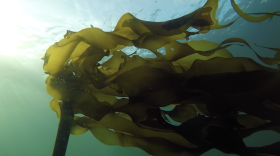Blue mussels and snails (whelks) collected from Unalaska Bay on July 4 registered nearly three times the U.S. Food and Drug Administration's Paralytic Shellfish Poisoning toxin limit for safe consumption.
A recent report of some of the highest ever recorded levels of PSP toxins in butter clams taken from the Alaska Peninsula community of King Cove in June prompted officials to test locally, according to Melissa Good, the Alaska Sea Grant Marine Advisory Agent in Unalaska.
"We recently got a report from King Cove, and it was showing PSP toxin levels in butter clams that were over 700 micrograms per 100 grams of tissue," said Good. "The FDA has 80 micrograms per 100 grams of tissue as the safe limit of consumption cutoff. So anything over 80 is considered unsafe by the FDA."
Good said PSP is a serious illness that is caused by eating shellfish that have been feeding on microscopic dinoflagellate algae (Alexandrium in Alaska) that produce highly poisonous toxins. When someone consumes shellfish that is contaminated with PSP, the neurotoxins – which are estimated to be 1,000 times more toxic than cyanide – can cause tingling, numbness, disorientation, paralysis, nausea, respiratory failure, and even death.
Sarah Spelsberg, a physician assistant at Iliuliuk Family and Health Services, said that local shellfish harvesters should be cautious. If someone is brought into the clinic with symptoms of PSP – experiencing numbness or tingling in their mouth after eating shellfish like clams or mussels – there's no way to predict how bad their reaction is going to be. While the clinic has a number of respirators, someone experiencing symptoms would likely need to be medevaced out of Unalaska and get to an ICU, she said.
"This is a really scary thing for us because we have no way of knowing how much they've had," said Spelsberg. "And the symptoms start out the same whether it's going to be a fatal case, a life-threatening case, or a survivable case."
The median time between consuming the shellfish and onset of symptoms is one hour, and the progression and intensity of the symptoms vary among individuals and are influenced by the level of toxin present and the amount of shellfish consumed.
"In general, it's important to understand that you could have a group of people all eating the same mussels, and it's possible that only one or two of them would get sick," Spelsberg said. "Because even in the same mussel bed, some of them might have more or less toxin in them. And it's just not worth the risk, in my mind."
If someone decides to harvest bivalves (mussels, clams, cockles, scallops, and rock jingle) in this region, it is highly recommended that they do not immediately consume their harvest, but freeze it and send in a sample to the Alaska Department of Environmental Conservation lab, said Good.
"Once the toxin levels start getting higher, you don't want to eat them," she said. "You can't cook out the toxin. You can't freeze out the toxin. There's really no way to get rid of it. So you just don't want to eat it. If you went out to harvest it, and the lab found high toxin levels, you want to completely discard all of your harvest."
Across the state, scientists are seeing warmer and warmer water temperatures, according to Good. Oceanic temperatures in the Bering Sea have quickly reached levels that promote toxic algal blooms in the region, so much so that scientists have found toxin levels higher than any they've seen before. She said the region is on a trajectory right now to start seeing more and more incidences of having high PSP toxin levels in shellfish.
For more information, contact Melissa Good by email at melissa.good@alaska.edu or by phone at 581-1876.






